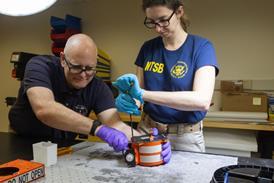Shielding avionics from electro-magnetic interference (EMI) becomes trickier with composites. Embedding wire meshes into the non-conductive composite material is a well-known solution, but it is not optimal.
Metal and composites expand and corrode differently, and the metal adds weight.
Carbon nanotubes (CNT) present the possibility of the perfect solution. For nearly 20 years, the super-strength, lightweight material has found commercial application in golf clubs and bicycles, but has made few in-roads into the aerospace industry.
That curious exclusion seems to be changing, and the EMI application is most responsible.
Earlier this month, NASA's Juno spacecraft launched into space using the CNT-based EMShield, produced by US-based Nanocomp Technologies.
The same company is also working on a proposed EMI shielding system for the Northrop Grumman MQ-4C broad area maritime surveillance unmanned air system.
CNT is a conductive and load-bearing material, so it can channel away undesired electromagnetic energy without adding the support structure required for metal-based EMI materials.
It may not be long before CNT becomes attractive in other niche applications.
The US Navy's MQ-4C, for example, needs a de-icing system to operate in medium-altitude surveillance mode.
Embedding strips of conductive CNT material into the wing's leading edge or engine nacelle is a potential solution.
The next step is to move CNT material from niche applications to aircraft structures.
Lockheed Martin made the first move earlier this year, announcing that the F-35 will feature a different kind of CNT material as wingtip fairings.
But Nanocomp chief executive officer Peter Antoinette is cautious when predicting the spread of nano-composite materials to load-bearing aircraft structures, even though CNT is several times stronger than steel or composite fibre-reinforced plastic (CFRP) for similar weight.
Antoinette notes that Boeing supplier Toray has invested heavily in creating an industrial capacity to supply CFRP to support a programme on the scale of the 787.
A similar investment would be required to move from CFRP to CNT material in mainstream commercial aviation programmes, he said.
The technology is more likely to evolve over several decades, he added. After building critical mass in niche applications, such as EMI and anti-icing systems, the CNT material could be applied in non-load bearing structures, such as the F-35's wingtip fairings.
Nanocomp sees an opportunity for using CNT to replace wiring systems in airline in-flight entertainment systems. That application is easier to achieve certification for, compared to navigation and safety-critical systems, Antoinette added.
Eventually, CNT could be applied in flight control structures and safety-critical systems.
Antoinette said: "I hate the way nanotechnology has been oversold for so many years and I suspect CFRP was too, so I suspect there will still be a place for metal [in future aerospace vehicles]."
Source: Flight International























